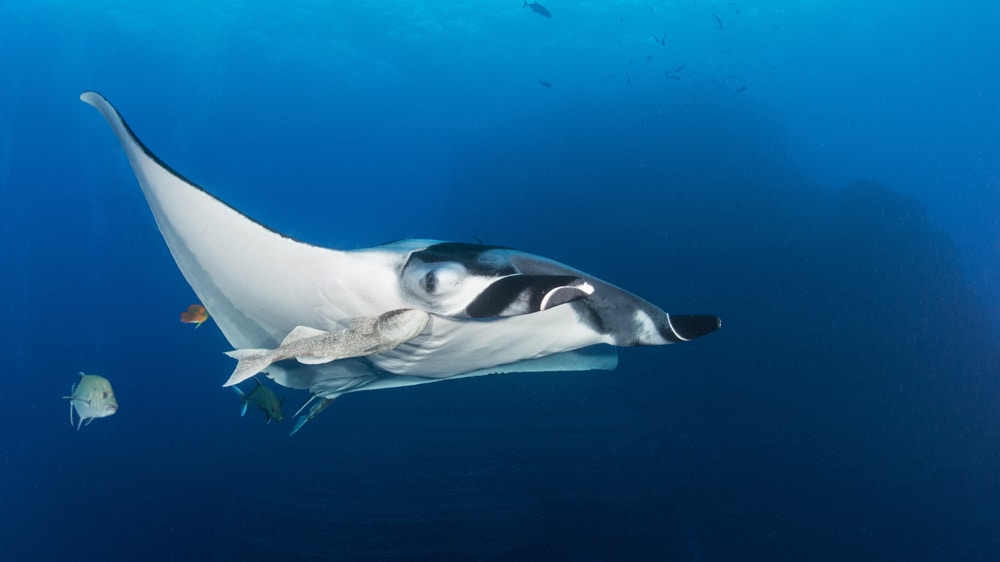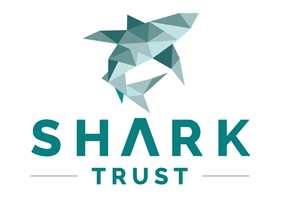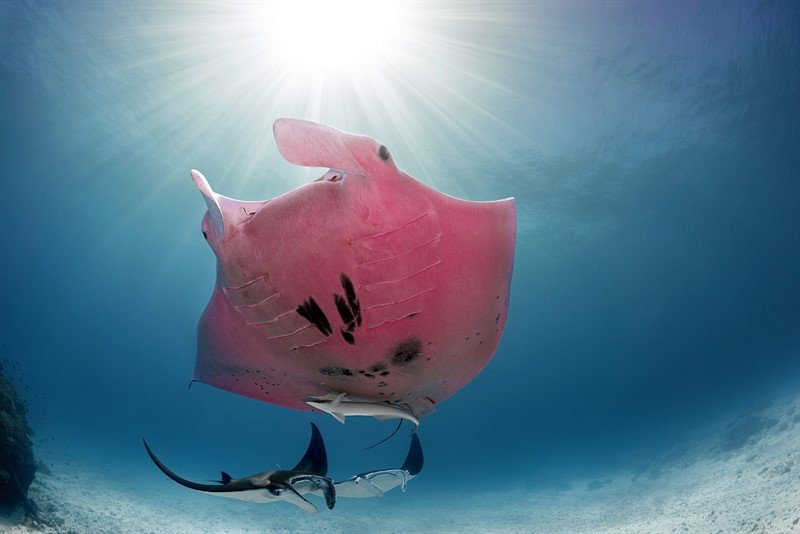Marine Life & Conservation Blogs
Creature Feature: Manta Rays

 In this series, the Shark Trust will be sharing amazing facts about different species of sharks and what you can do to help protect them.
In this series, the Shark Trust will be sharing amazing facts about different species of sharks and what you can do to help protect them.
This month they’re showcasing the largest rays in the world. Made up of 2 different species, these captivating giants are highly intelligent. And, come in a range of unusual colours!
The word ‘manta’ is Spanish for blanket or cloak, which perfectly describes the body-shape of a manta ray. These enormous, flat, diamond-shaped animals, have wingspans stretching up to 7m wide and can weigh up to 1,350kg.
Mantas also have 2 horns at the front of their head, giving them the nickname ‘devil fish’. But there’s nothing devilish about these gentle giants. Or their close cousins the devil rays, who often get confused for mantas. Both, use their ‘horns’ (or cephalic fins) during feeding to scoop up tiny plants and animals in the water. Similar to how we use a spoon to eat soup. Their cephalic fins may also play a role in sensing their environment and during social interactions.
Just like the Basking and Whale Shark, manta rays are filter feeders. Swimming with their mouths wide open, they suck in huge volumes of water – rich in zooplankton. Their tiny prey is then filtered through gill plates that line their mouth. Sadly, these gill plates are highly sought after in the Chinese medicinal trade, which has led to mantas being heavily over-fished.
As any diver can attest, seeing a manta in the wild is a pure delight. Their elegance and grace in the water is unrivaled. Particularly at feeding time. Mantas need to keep moving to breathe, so individuals will perform multiple somersaults to stay in a single spot where there’s lots of food. Like a perfectly orchestrated dance, mantas will also follow each other in a circle to chain-feed. Their movements expertly creating a vortex that traps their prey inside.
Manta Rays live in tropical, subtropical, and temperate waters around the world. They tend to live on their own or in small groups. But will often gather in large groups to feed. Hotspots for this feeding behaviour include the Bahamas, Fiji, Indonesia, Thailand, Spain and the Maldives. And aggregations are known as a squadron of manta ray.
In 2008, scientists discovered that the Manta Ray, which was once thought of as a single species, was in fact two different species. The Giant Oceanic Manta Ray (Mobula birostris) and the much smaller Reef Manta Ray (Mobula alfredi). Both species were formerly classified under the separate genus Manta. But following genetic testing in 2017, scientists discovered they were more closely related to devil rays (genus Mobula) than previously thought and reclassified them as such.
The Giant Manta is widespread, spending most of their time far from land in open ocean. While the Reef Manta tends to prefer the warmer coastal waters of the Indo-Pacific. Fully grown, the wingspan of a Giant Manta can reach up to 7m (typically 4.5m). While the largest wingspan for a Reef Manta is 5m (typically 3-3.5m). Both are dark in colour on top with a pattern of white lines. On the Giant Manta the white lines form a T shape, while on the Reef Manta they form a Y shape.
We can also identify each individual manta by their unique markings. Found on the underside of their body (between the gills and on their bellies), these act just like a human fingerprint. Enabling scientists to use photo-ID to discover more about them.
Manta Rays regularly visit cleaning stations, like many other marine animals, often returning to the same spot. Here smaller animals groom them, removing pesky parasites and dead skin. These spa trips to the coral reef provide researchers with the perfect opportunity to photograph and study them in the wild.
In Raja Ampat, researchers have discovered an unusual group of Reef Mantas, affectionately known as the ninja warriors. This area has the highest percentage of melanistic (black) Reef Mantas in the world. Usually melanistic mantas comprise around 10% of a population, but here they represent 40%. This genetic trait is inherited and doesn’t appear to affect their survival rate.
If you visit the Great Barrier Reef, you may witness an even more astounding sight…
A 3m male Reef Manta named ‘Inspector Clouseau’, who also happens to be bright PINK! Big thanks to Kristian Laine Photography for providing the incredible photo above.
The Inspector is the only known pink manta in the world. His rosy hue is believed to be the result of a condition called erythrism – a genetic mutation in melanin production. Again, this doesn’t seem to impact his survival. Indeed, he’s been spotted a handful of times since his first debut in 2015, so is doing well.
Highly intelligent, these majestic animals have the largest brain to body weight ratio of any fish. Studies suggest they have high cognitive function – similar to dolphins, primates and elephants – and excellent long-term memory.
Due to their large size, adult mantas don’t have many natural predators. Although, larger sharks and orca have been known to prey on them. Yet, the biggest threat they face comes from humans. Due to their low reproductive rate mantas are incredibly vulnerable to over-fishing.
These long-living animals are thought to live up to 50 years. Giving birth every 4-5 years, they’ll only produce between 4-7 pups during their lifetime.
GIANT MANTA RAY:
- SCIENTIFIC NAME: Mobula birostris
- FAMILY: Mobulidae (Manta & Devil Rays)
- MAXIMUM SIZE: 7m
- DIET: Zooplankton, krill & small fish.
- DISTRIBUTION: Worldwide in tropical and temperate waters. Found from the surface to depths of 1,000m.
- HABITAT: Spends long periods of time in the open ocean. Visits shallow coastal waters near coral and rocky reefs.
- CONSERVATION STATUS: Endangered
REEF MANTA RAY:
- SCIENTIFIC NAME: Mobula alfredi
- FAMILY: Mobulidae (Manta & Devil Rays)
- MAXIMUM SIZE: 5m
- DIET: Zooplankton, krill & small fish.
- DISTRIBUTION: Tropical and sub-tropical waters of the Indian and Pacific Ocean. Found from the surface to depths of 432m.
- HABITAT: Shallow coastal waters near coral and rocky reefs. Moves into deeper waters at night to feed.
- CONSERVATION STATUS: Vulnerable
Header Image: Frogfish Photography
Marine Life & Conservation Blogs
Book Review: Shells of the World

Shells of the World: A Natural History by M.G. Harasewych
Shells of the world is a guide to the world of marine, shelled molluscs. And what a varied and interesting world it is. Some of my favourite things to find on a dive are detailed in this book, including disco clams (or Electric File Clams as they are correctly names), the cephalopods, giant clams and sea hares. There are also many on my wish list, top of which is the Nautilus.
Each chapter provides a detailed description of the species, along with beautiful images. You can dive deeper and discover where they live, both with global distribution and the habitat they prefer. Learn about their diet, reproduction and diversity.
Having dipped in and out of this lovely book over the past few weeks, it has inspired me to learn more about this group of animals that we see on most divers, wherever we are in the world. Some of the shells are incredibly intricate and beautiful. I have always agreed with never collecting, or touching, marine life. The description of a certain set of cone shells should be a warning to those that are happy to pick up marine life! One of the cone shells has a local name called the cigarette snail. Why? Because once the venom is in your system from this animal, you only have time to smoke one cigarette before the affects of the venom are fatal!
What the publisher says:
Mollusks are invertebrate animals with a remarkable natural history and a rich fossil record, and their shells are prized for their breathtaking variety and exquisite beauty. Shells of the World provides a wide-ranging look at the incredible diversity of marine mollusks. An informative introduction outlines the lineages covered, followed by a directory section, split into classes, that profiles a broad selection of different taxa to give a sense of their sheer numbers and variety.
- Features hundreds of beautiful color photos, depicting both the live animals and their shells
- Discusses mollusk evolution, anatomy, life cycles, behavior, and ecology
- Describes unique characteristics, distribution, habitat, and size
- Provides valuable insights into the conservation of the world’s marine mollusks
- Ideal for malacologists and shell collectors everywhere
About the Author:
M. G. Harasewych is research zoologist emeritus and former curator in the Department of Invertebrate Zoology at the Smithsonian Institution’s National Museum of Natural History. A fellow of the American Association for the Advancement of Science, he is the author (with Fabio Moretzsohn) of The Book of Shells: A Life-Size Guide to Identifying and Classifying Six Hundred Seashells.
Book Details
Publisher: Princeton University Press
Hardcover
Price: £25
ISBN: 9780691248271
Published: 9th April, 2024
Blogs
The Ocean Cleanup Breaks 10,000,000 KG Barrier

The Ocean Cleanup, the global non-profit project, has removed a verified all-time total of ten million kilograms (22 million lbs.) of trash from oceans and rivers around the world – approximately the same weight as the Eiffel Tower.
To complete its mission of ridding the oceans of plastic, The Ocean Cleanup uses a dual strategy: cleaning up the Great Pacific Garbage Patch (GPGP) to remove the plastic already afloat in the oceans, while stopping the flow of plastic from the world’s most polluting rivers.
Through cleaning operations in the GPGP and in rivers in eight countries, the cumulative total of trash removed has now surpassed ten million kilograms. This milestone demonstrates the acceleration of The Ocean Cleanup’s impact, while underlining the astonishing scale of the plastic pollution problem and the need for continued support and action.
While encouraging for the mission, this milestone is only a staging point: millions more tons of plastic still pollute our oceans and The Ocean Cleanup intends to continue learning, improving and innovating to solve this global catastrophe.
This announcement comes as governments from around the world meet to continue negotiations to develop a new legally binding instrument to end plastic pollution at INC4 in Ottawa, Canada. Representatives of The Ocean Cleanup will be in attendance and the organization will be urging decision-makers to collaborate towards a comprehensive and ambitious global treaty which addresses plastic at all stages of its life cycle and in all marine environments worldwide, including in areas beyond national jurisdiction.
It is encouraging to see that the need for remediation is reflected in the various options for potential treaty provisions. It is essential that the final treaty contains clear targets for the remediation of legacy plastic pollution, and reduction of riverine plastic emissions.
Tackling plastic pollution requires innovative and impactful solutions. The treaty should therefore incentivize the innovation ecosystem by fostering innovations that make maximal use of data, technology and scientific knowledge – such as those designed and deployed by The Ocean Cleanup.
‘After many tough years of trial and error, it’s amazing to see our work is starting to pay off – and I am proud of the team who has brought us to this point.’ said Boyan Slat, Founder and CEO of The Ocean Cleanup. ‘While we still have a long way to go, our recent successes fill us with renewed confidence that the oceans can be cleaned.’
The Ocean Cleanup was founded in 2013 and captured its first plastic in 2019, with the first confirmed catch in the GPGP coming soon after the deployment of Interceptor 001 in Jakarta, Indonesia. After surpassing one million kilograms of trash removed in early 2022, the non-profit project has since progressed to the third iteration of its GPGP cleaning solution, known as System 03, and a network of Interceptors currently covering rivers in eight countries, with more deployments set for 2024.
About The Ocean Cleanup
The Ocean Cleanup is an international non-profit organization that develops and scales technologies to rid the world’s oceans of plastic. They aim to achieve this goal through a dual strategy: stemming the inflow via rivers and cleaning up the legacy plastic that has already accumulated in the ocean. For the latter, The Ocean Cleanup develops large-scale systems to efficiently concentrate the plastic for periodic removal. This plastic is tracked and traced through DNV’s chain of custody model to certify claims of origin when recycling it into new products. To curb the tide via rivers, The Ocean Cleanup has developed Interceptor™ solutions to halt and extract riverine plastic before it reaches the ocean. Founded in 2013 by Boyan Slat, The Ocean Cleanup now employs a broadly multi-disciplined team of approximately 140. The foundation is headquartered in Rotterdam, the Netherlands.
For more information, visit: theoceancleanup.com and follow @theoceancleanup on social media.
-

 News3 months ago
News3 months agoCapturing Critters in Lembeh Underwater Photography Workshop 2024: Event Roundup
-

 Marine Life & Conservation Blogs3 months ago
Marine Life & Conservation Blogs3 months agoCreature Feature: Swell Sharks
-

 Gear Reviews4 weeks ago
Gear Reviews4 weeks agoGEAR REVIEW – Revolutionising Diving Comfort: The Sharkskin T2 Chillproof Suit
-

 Blogs2 months ago
Blogs2 months agoMurex Resorts: Passport to Paradise!
-

 Blogs3 months ago
Blogs3 months agoDiver Discovering Whale Skeletons Beneath Ice Judged World’s Best Underwater Photograph
-

 News3 months ago
News3 months agoPADI Teams Up with Wellness Brand Neuro to Drive Ocean Change and Create a Blue State of Mind
-

 Gear Reviews3 months ago
Gear Reviews3 months agoGear Review: Oceanic+ Dive Housing for iPhone
-

 Marine Life & Conservation2 months ago
Marine Life & Conservation2 months agoSave the Manatee Club launches brand new webcams at Silver Springs State Park, Florida



















